May 2007 (Part 3)
SELECTION OF QUESTIONS AND ANSWERS
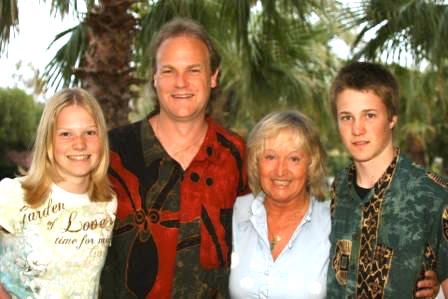
Here is a photograph showing the happy family of Sifu Andrew Barnett, his wife and their two lovely children on holidays in Turkey. Having a happy family is a cherished value in our school, Shaolin Wahnam.
Question 1
Losing my girlfriend has set me back a little. This is I believe the main problem I have faced in training internal arts over the past 3 years -- I have had one girl after another break my heart and have felt so bad that for probably 90% of those 3 years I have struggled to smile from the heart genuinely.
— John, UK
Answer
Your main problem is not girls constantly breaking your heart but your perverted view. In chi kung terms, it is your mental blockage. Once you have cleared this mental blockage, you will not only overcome feeling miserable, but also be able to find a good girlfriend.
I am going to explain to you a time-proven method to overcome this problem. The method comes in two parts, the philosophical and the practical.
Philosophically, the girls did not break your heart. It was you yourself who allowed your heart to be broken. Luckily, it was not too serious. You recovered enough to repeat similar processes.
If you analyze your feelings more deeply, you would find that actually you were not in love with any of the girls; you were in love with love itself. In love with love is not a bad thing, but you need to find the right girl to place your love in.
You will have your own choice of qualities to look for in the right girl. But I shall mention one important quality. She must also love you. This may or may not be the first or second most important quality you want in your right girl, but it is an essential quality. In other words, no matter how wonderful she may be, if she does not also love you, then she is not your right girl. You should not waste your time on her. There are literally thousands of other eligible girls elsewhere.
This is the first part of the method to overcome your problem. Be reminded that the problem here is not how to find the right girl — this will be explained later. The problem here is that you allow your heart to be constantly broken and you feel very bad about it. To avoid this happening again, you have to clear your mental blockage by understanding the following three points:
- The girls themselves did not break your heart. You allow your heart to be broken.
- This happened because you were in love with love. Somehow you believed that having your heart broken was part of the process of being in love. This was a perverted view. You should find the right girl to place your love in.
- You can choose the qualities you like in your right girl, but an essential quality is that she must also love you. Otherwise, don't waste your time on her. There are literally thousands of other lovely girls waiting for you to sincerely love them.
Now the practical part, which is simple yet very profound.
Early every morning go to the open, or to an open window if the weather outside is unfavorable, and smile from the heart. Just do this. Just smile from the heart. Simple. And profound.
Question 2
My main aims in life are to have a wife and family, and to excel at kungfu. My failure to achieve the first aim so far makes me feel bad for myself, and also for my parents who would love to see me meet a nice girl.
Answer
Your aims are very noble.
You already have the means to accomplish your second aim of excelling at kungfu. Just practice what you have learnt from me, and enjoy your practice. You will certainly excel at kungfu.
If you follow the method explained above, both the philosophical and the practical parts, you will soon overcome your problem of feeling that girls keep breaking your heart, and you feeling bad about broken relationships.
You will soon find that girls are wonderful. You will feel good. Your task, then, is to find the right one for yourself. You will soon accomplish your first aim of having a good wife and family and making your parents happy.
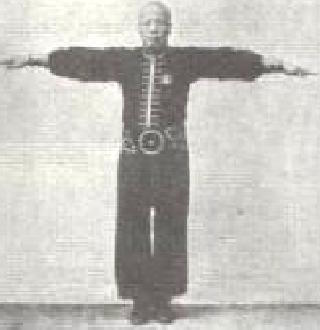
An old photograph provided by Sifu Pavel Macek showing Grnadmaster Lam Sai Weng performing the pattern “Sideway Pressing Three Times Shooting Palms” in the famous Taming-Tiger Set.
Question 3
My approach lately has been to continue to develop my jing, chi and shen, to set aims and objectives towards the target, and to follow the 10 Shaolin Laws hoping that the Cosmos will reward me with a good woman.
Answer
What you have done is only the preparation, which of course is important.
Remember that God or the Cosmos help those who help themselves. Don't just hope and wait. You have to actively go out and work hard and honestly to get a good wife.
Most important, you yourself must be a good husband. How you can do so and succeed will be explained below.
Question 4
I loved your answer to Flora of Spain where you told her how a woman could find and keep a husband. From the male perspective I know that although feminists might not agree, your suggested tactics would work 100%. You also told her how to be a good wife, and told someone else how to be a good husband.
Answer
The method I described has worked well for many people. I am sure it will work well for Flora.
I think that many feminists will also agree. Some have privately confessed that the so-called feminist movement is a failure, resulting in many women unable to find husbands. Indeed, the term “feminist” is a misnomer. The movement has made many women masculine, not feminine.
In their heart, women want to be women; they do not want to be men. They want to be treated respectfully as women. They want men to open doors for them, carry their luggage, and patiently wait for them as they help themselves first with their choicest food. They do not want to jostle for food at parties, smell of liquor, smoke cigars and put their feet on tables. Neither do men want such masculine women.

Sifu Ronan Sexton of Shaolin Wahnam England performing “Three Times Pressing Pearls” at the greeting pattern of the “Four Gates” set.
Question 5
Would you have any specific advice or tactics to offer for a man who wants to find a good girlfriend or wife?
Answer
Yes, I have plenty, and they have worked very well.
The “Four Modes of Preparation” and the “Three Arrivals” are very good guidelines.
First, you have to prepare yourself. This you have done quite well. You are handsome, of the right age, have a good job, and, most significantly as it gives you a very big advantage, you practice our Shaolin Wahnam arts and philosophy.
At the risk of sounding egoistic to non-Shaolin Wahnam members, I would go so far to say that those who marry Shaolin Wahnam men or women are extremely lucky. Why? Because Shaolin Wahnam men and women are healthy, full of vitality, have mental clarity and freshness, hold and practice high moral values, and love life.
The second mode is to observe your “opponents”, which is read here as “potential girlfriends”. First, remind yourself how lucky you are, compared to, for example, people in the UK three hundred years ago, or people now in other countries like Saudi Arabia or India. There are literally thousands of lovely women at any one place in the world waiting for good eligible men to date them, but cultural and other factors are such that it is much easier done in UK than in most other countries.
The third mode is to evaluate your opportunities. Seize them when they arise, or create them if they are not currently present. There may be thousands of eligible girls in the UK, but if you spend most of your time bird watching in the countryside or practicing meditation with Zen monks, you are unlikely to get a girlfriend.
If you are in an unlikely situation where they are few or no eligible girls in your surroundings, go to where there are plenty. For example, enroll yourself in classes of cooking, folk dancing or yoga where you can meet many lovely girls, many of whom are also waiting to meet charming men like you. If you know nothing or are not interested in these subjects, it is an added advantage for you to ask the lovely girls to teach you or challenge them to arouse your interest.
Now you are with a group of lovely girls cooking, dancing or practicing yoga. Of course, merely cooking, dancing or practicing yoga with them is not your goal. You have to date them, take them to discos, parties, cinemas, dinners or wherever you and your girlfriend can spend some quality time together. Society has progressed so far that now all you have to do is to ask them for a date, simply and sweetly. Still, you have to use your tactics. The “Three Arrivals” are good guidelines.
First, you must be clear where you want to take her to, and how you are going to make her happy spending time with you. Two, you must do so at a favorable time and place. And three, just do it. Ask your dream girl for a date.
Asking her for a date when she is busy with her work or when she is with many friends may not be a suitable time and place. If necessary, you can ask if she can excuse herself from her group for a minute, and tell her in private that you would like to have a date with her. She would feel thrilled by your effort even if she could not accept your date.
If a girl accepts your date, fine, have a nice time together. If she declines, fine too, but ask her again another time. If she declines again, ask again. Faint heart never wins a fair lady. But if she continuously declines your date, don't waste further time on her. Ask someone else. Remember that a basic tenet is not to waste your time and her time on a girl who does not love you.
Getting a date is relatively easy. The difficult part is how to make your girlfriend value the time spent with you. Asking her, before you actually date her, where she would like to go and what she would like to do when someone dates her, is helpful. Then, at a suitable time and place, you tell her that you would like to make her wish come true. Showing care and consideration for her will win her heart, but you must not overdo it.
As your dates progress, you can subtly suggest marriage. You may, for example, mention that it is wonderful to have a family where you can always go back to a loving wife and happy children. Then propose and marry her and live happily ever after, though disagreement may sometimes crop up to add spices to your happily married life.
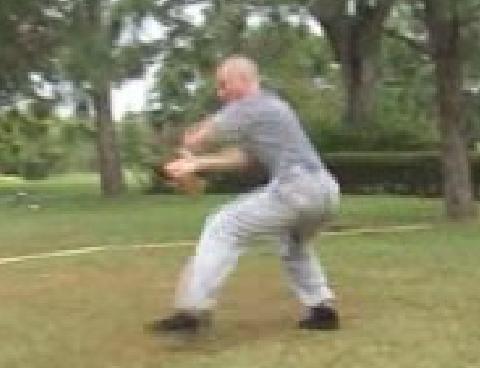
Sifu Ronan Sexton demonstrating the pattern “Phoenix Flaps Wings” which executes a “luk jaang” or “rolling elbow” technique
Question 6
What is the meaning and translation of “saam jyu” in the “Taming the Tiger” manual (eg. Figures 5, 13) please? Is the Chinese character correct?
— Sifu Pavel, Czech Republic
Answer
The Chinese character “jyu” (“zhu” in Mandarin) means roots that surface on the ground. It also means the space between two rows of trees. It is also used as a numerical co-efficient for trees and plants. Numerical co-efficients are used in Chinese, but not in English.
For example, in English we say “one tree”, “two persons”, but in Chinese (and some Asian languages) we say “one (jyu) tree”, “two (ke) persons”, where “jyu” and “ke” are numeral co-efficients which do not carry content meanings but serve grammatical functions indicating the types of nouns referred to. Saying “one (ke) tree” or “two (jyu) persons” is grammatically incorrect.
“Saam jyu” as written in Grandmaster Lam's classic means “three times”. Hence in Pattern 5 of the Taming-Tiger Set, the seven-character pattern name means “Sideway Pressing Three Times Shooting Palms”, and in Pattern 13 it means “One Finger Three Times Throw Elbows Technique”.
Notwithstanding this, it is possible that “jyu” as a numerical co-efficient is mistakenly written for “jyu” meaning “pearl”. In Chinese, “pearl” and the numerical co-efficient sound the same, but there is a slight difference in their written words. Hence “saam jyu” may refer to “three pearls” instead of “three times”, though it does not actually matter because whether they are “pearls” or not, they are also moved forth and back three times. (Please see my answer on “lin jyu” or “continuous pearls” later on.)
I still remember clearly that when I first learned “Cross-Roads at Four Gates” from Sifu Ho Fatt Nam, I was pleasantly surprised that its signature greeting pattern was remarkably similar to the greeting pattern (Patterns 5 to 8) in Grandmaster Lam's Taming-Tiger Set, except that we did the “sideway pressing three times shooting palms” on a Horse-Siding Stance whereas you do so while standing upright. We call this pattern “Sam Pik Jyu Kiew” (“Three Times Pressing Pearl Bridge”). This suggests that we come from the same source, i.e. the southern Shaolin Temple.
Pressing or Stretching Three Times, sideways as well as frontal where it is known as “Sam Chuin Jyu Kiew” or “Three Times Threading Pearl Bridge”, is a very important aspect of internal force training in Southern Siu Lam (Shaolin). It is found in the Tiger-Crane Set in patterns like “One Finger Stabilize Central Plain” (Pattern 7), “Left Circulating Soft Bridge” and “Right Circulating Soft Bridge” (Patterns 20 and 21), and in the Iron-Wire Set in patterns like “Three Times Pearl Bridge” (Pattern 7), “Tiger Roar Dragon Chants” (Pattern 17), and “Stabilize Golden Bridge” (Pattern 32).
Stretching Three Times is a signature internal force training method in Shaolin Wahnam. It is found in our fundamental force training in “One-Finger Shooting Zen”. It is also found in the internal force training aspect of many sets, like in the “Double Dragon Emerge from Sea” pattern of Dragon Form Set, Dragon-Tiger Set and Dragon Strength Circulating Chi Set, and in the “Single Dragon Emerges from Sea” of Five-Animal Set, Tripple-Stretch Set and Flower Set.
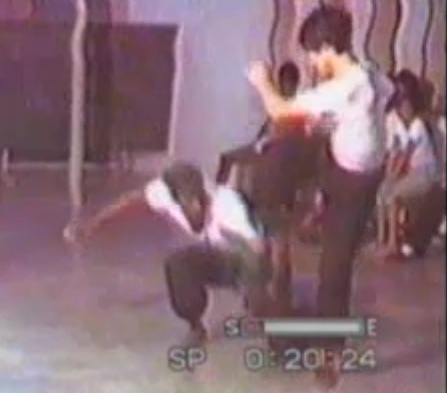
An old picture showing Mogan and Kok San sparring with the Four-Gate Combination Set
Question 7
What is the meaning and translation of “chaang geuk” in the “Taming the Tiger” manual (eg. figures 18, 27) please? Is it the kick or the stepping into the stance after the kick?
Answer
“Chaang geuk” literally means “spade leg”. It is a kicking technique where you shovel your foot, like a spade, into an opponent, particularly into his shin or ankle. You can use the inside edge or the outside edge of your foot for the shoveling attack.
This shoveling technique, or “shovel-kick”, can be used in numerous ways. It can be used as a kick by itself, or as stepping into your opponent's stance, or as stepping into your own stance like a Unicorn Stance where you break your opponent's ankle.
Question 8
What is the meaning of “luk jaang” in the “Taming the Tiger” manual (figure 62) please? The characters seem to be very special in Cantonese dialect of Chinese.
Answer
“Luk jaang” means “roll elbow”. Both characters are typically Cantonese, which is closer to classical Chinese. These terms are not found in Mandarin, which is a modern dialect composed from Pekinese and Manchurian, and used as the official language during the Qing or Manchurian Dynasty.
Many classical Chinese terms in kungfu as well as other disciplines, therefore, are more easily comprehensible and appreciated in Cantonese than in Mandarin. Chinese classical poetry, for example, often does not sound “right” in Mandarin, but sounds poetic in Cantonese. Shaolin Kungfu terms are usually in classical Chinese, or in modern context, in Cantonese. Taijiquan terms, as they came later, are usually in Mandarin.
Cantonese and Mandarin are the same Chinese language. The words are the same, but the pronunciation is different. In other words, the same written Chinese can be understood, generally, by both Cantonese and Mandarin speakers. However, as people at different periods use different words to describe the same things or events, the Cantonese way of speaking and writing may be different from the Mandarin way.
Let us take “luk jaang” as an example. In Mandarin the same concept would be spoken and written as “ji zhou”. Hence, not only the pronunciation is different, the written words are also different. If you show the written words “ji zhou” to a Cantonese speaking person, he would not pronounce it as “ji zhou”, but pronounce the same words in Cantonese as “khaik chow”. (Reversely, if you show the written words “khaik chow” to a Mandarin speaking person, he would pronounce them as “ji zhou”.)
But “ji zhou” (or “khaik chow”) is not exactly the same, or as rich, as “luk jaang”! That part of the body where the upper arm meets the forearm at the outside was called by the Chinese people in classical times, and is called by Cantonese speaking people now as “jaang”, but is called by Mandarin speaking people now as “zhou”, and is called by English speaking people now as “elbow”. “Ji” (or “khaik”) means “strike”. Thus, “ji zhou” means striking with an elbow. But it does not indicate how you strike with your elbow.
“Luk jaang” is more descriptive. It indicates that you strike your opponent with an elbow by rolling it into him. Suppose you opponent is at north. Your elbow would travel from east or west to north. And it may not necessarily travel in a horizontal plan. If your elbow strike travels from south to north, it would be called “teng jaang”, which means “thrust elbow”.
In the pattern you mentioned, Pattern 62 of Taming-Tiger Set, an opponent comes close from behind to attack you. You turn around from a left Bow-Arrow Stance to a right Bow-Arrow Stance and strike your opponent with “teng jaang”, or “thrust elbow”. If he brushes away your “thrust elbow” and counter-attack, you can deflect his attack with a “roll-elbow”. You may also attack him with a “roll-elbow”. All these are quite clear if you use the Cantonese terms, “teng jaang” and “luk jaang”. If you use the Mandarin term, “ji zhou”, which does not distinguish how you use your elbow, it would not be as clear.
Cantonese speakers would understand the written words “ji zhou” (“khaik chow”), but Mandarin speakers may not understand the written words “luk jaang”, simply because these classical words are not in their modern vocabulary.
Worse, if you show these words written in standard Chinese, not in their simplified forms, the great majority of people in mainland China, including many scholars, as well as many people all over the world who study Chinese today, will not understand them! This is because in their haste to modernize China, the early government did away with classical Chinese and used only simplified Chinese.
The intention was noble, it was to enable the mass to be literate. But they did not foresee that twenty years later when their children have grown up, the people could not read the tremendous amount of wisdom written in classical Chinese. This is a big problem facing modern China, though not many people are aware of it.
You may be interested to know that Cantonese rather than Mandarin could have been the official language of China. When China became a Republic after overthrowing the Qing Dynasty, the new provisional Legislative Council called for a meeting to choose the national language for China. Most of the revolutionaries spoke Cantonese, whereas most of the warlords spoke Mandarin. Being a gentleman he was, Dr Sun Yat Sun who was Cantonese, did not vote as he was the Chairman.
The result was that the Mandarin speaking members won by just one vote. Had Dr Sun Yat Sun, the father of the Chinese Republic, voted, there would be a tie. As Dr Sun Yat Sun was the Chairman, he had the deciding vote, and Cantonese would be the Chinese national language. Personally I felt it was a great pity. With due respect to Mandarin speakers, I believe Chinese language and literature would be much richer had the council then chosen Cantonese.
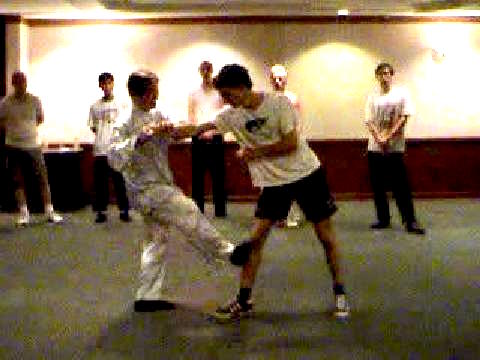
Grandmaster Wong applies a “shovel kick” using the pattern “Fierce Tiger Enters Rock” on Alex
LINKS
Selected Reading
- Gentle and Elegant, yet Forceful and Combat Effective
- I Couldn't Have Asked for a More Wonderful Experience
- Good Health is Our Birth-Right
- First Avoid Defeat, Then Secure Victory
- Dublin is Good for You
